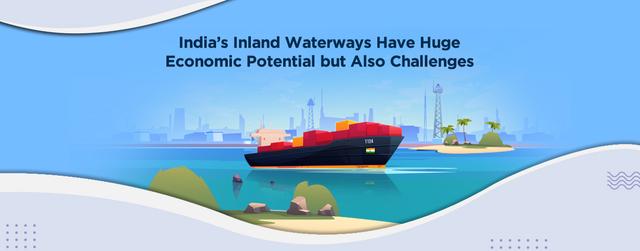
Cogoport: A Global Trade Platform
Cogoport leverages technology and caters to enterprises of all sizes. Our solutions improve predictability and enhance human capabilities.
India has over 14,000 km of navigable waterways. All the stakeholders stand to gain if certain fundamental challenges of the inland waterways are addressed by the government. For starters, all states need to have a standard rule book for the movement of goods through inland waterways.

Inland waterways in India have the potential to reduce logistics costs and delivery time for goods. The volume of goods shipped through inland waterways is steadily increasing but remains below capacity. There are multiple challenges for the sector, and if the government really wants the sector to blossom, it needs to make the inland waterways ecosystem more attractive for the private sector.
India is geographically a vast and diverse country, ranked seventh in the world by area. Many regions of the country are still not well connected by major rail and road networks. Nonetheless, regions in the northeast of the country have several rivers, and these can be used to navigate freight vessels. Transporting goods through inland waterways is cheaper compared to other options. Since India already spends 8.35% of its GDP on logistics according to the National Council of Applied Economic Research (NCAER), any further savings in cost will benefit all the stakeholders in the value chain.
If we compare the cost of freight for rail, road and inland waterways, the cost of freight per km for surface transport is lowest in inland waterways transport. This was validated in a study conducted by Rail India Technical and Economic Service (RITES), an engineering consultancy corporation, specializing in the field of transport infrastructure.

The total cargo movement through inland waterways, for the financial year 2020-21, in India stood at 881.40 lakh metric tons. To put things into perspective, major Indian ports reported 7,193.80 lakh metric tons of traffic movement in 2021-22. When we compare inland waterways and ocean freight, the former is 12.25 percent (approximately 1/8th) of the latter.
As per data provided by various state governments, the total length of rivers, canals and lakes in India is 34,195.30 km. Out of this, only 43.43 percent, i.e., 14,850.15 km is navigable.

The inland waterways in India have huge economic potential. Governments, at both the central and state levels, have been trying to integrate the waterways to the supply chain ecosystem. Due to various policy measures, the quantity of goods moved through the inland waterways is increasing every year.
Factors like shallow water, narrow width during dry weather, siltation and bank erosion, inadequate vertical and horizontal clearances in a large number of overhead structures make navigation throughout the year a daunting task.

The challenges faced by the inland waterways sector are as follows:

In a recently published report of the Ministry of Ports, Shipping & Waterways Research Wing, movement of cargo along India Bangladesh route of National Waterways (NW) I by Indian registered vessels have shown a growth of 3.98% in year 2020-21 over that in 2019-20. The cargo moved over this route has increased to 35.97 lakh metric tons in 2020-21 against 34.60 lakh metric tons in 2019-20.
In July, Maersk completed the first India-Bangladesh cross-border logistics of containerized cargo using the inland waterways of the Indo-Bangladesh Protocol Route for Coca-Cola. It transported 50 containers (TEUs or Twenty Feet Equivalent Units) from Kolkata in India to a river port near Dhaka in Bangladesh on a barge on the National Waterways 1.